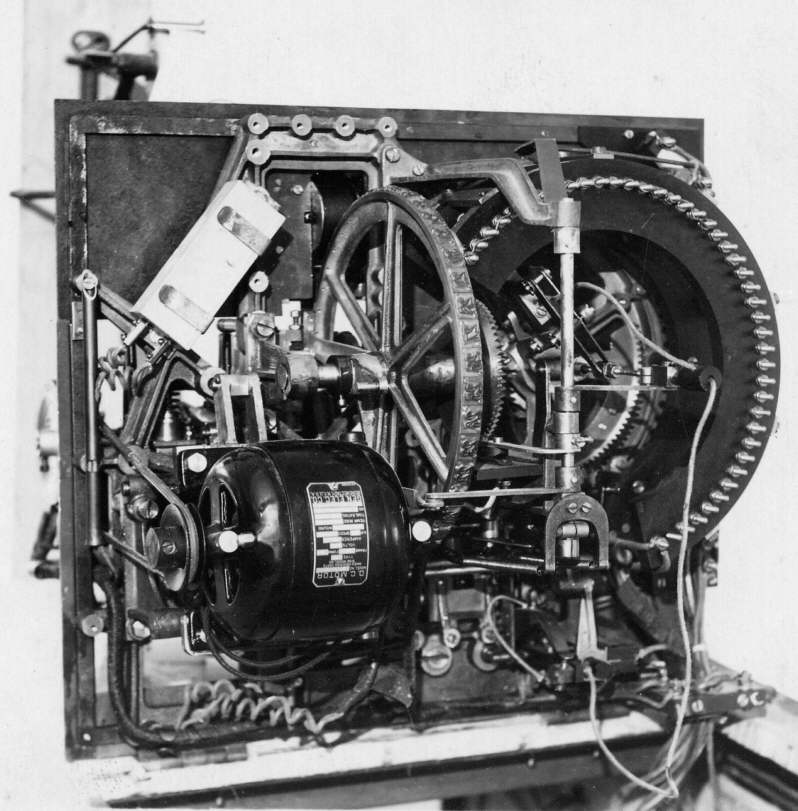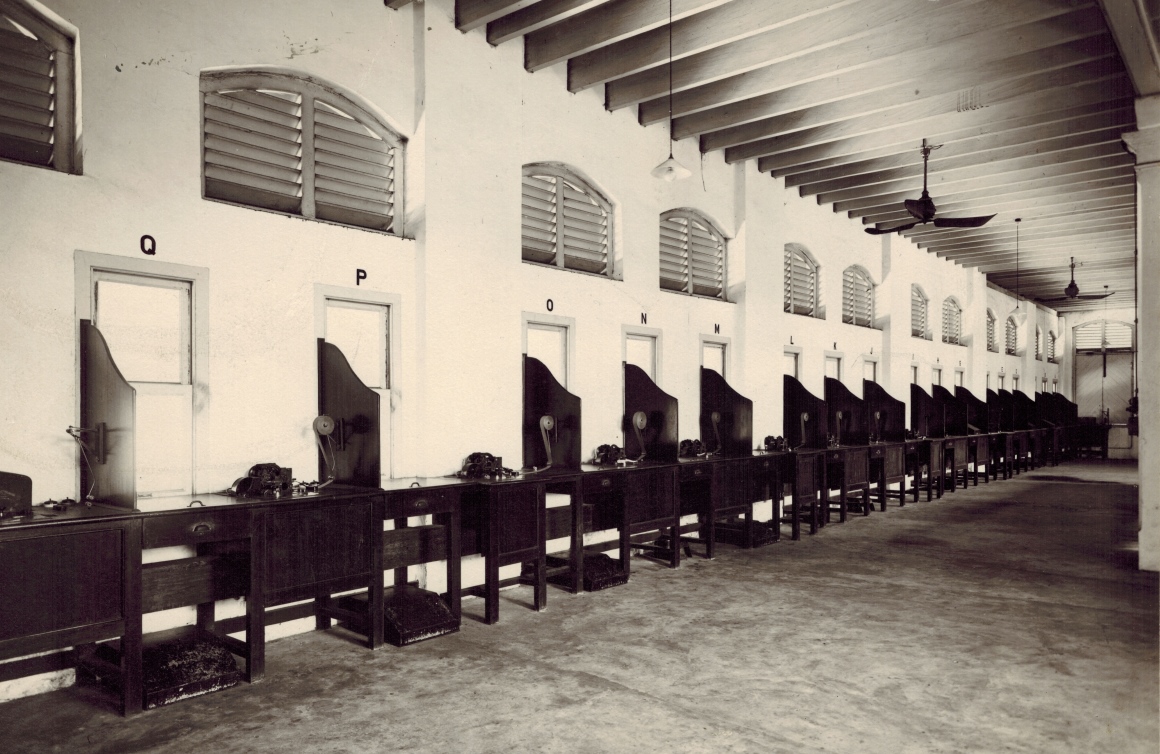This history of technology page contains a photograph which is one of several belonging to the photo gallery pages which are part of several pages relating to the invention of the world's first automatic totalizator in 1913 and Automatic Totalisators Limited, the Australian company founded in 1917 to develop, manufacture and export these systems.
Copyright © 1998 Email - totehis@hotmail.com
The workings of a J6 TIM 1935
The first image below is an image of a J6 Ticket Issuing Machine (TIM) that was one of many in a single Julius Tote installation. It is an example of an electro-mechanical TIM and looks like it is installed on a teller's bench at a racetrack belonging to a customer of Automatic Totalisators Limited. The wiring at the bottom right of the image looks like this J6 is part of a permanent installation and connects the ticket issuing machine with the Julius Tote Mainframe which will be somewhere on the customer's racetrack. At the top left of the image, part of a ticket paper holder and feeder can be seen attached to a panel on the bench behind the TIM. This paper holder and feeder has paper threaded on it adding to the impression that this machine is part of a permanent installation, where it is being used on race-days. The J6 is shown raised in the maintenance position and in operation would be swung down, from this vertical position to a horizontal position, on the hinges which can be seen at the bottom of the machine, where it is sitting on the bench. In this normal horizontal position, all the machinery visible in the image will be out of sight under the bench, with the operator controls on the opposite side of the TIM in the image and presently out of sight, accessible by the teller sitting at the bench.
More after the image...

Click on the image to go back to the Photo Gallery
The following image in the Photo Gallery of this website shows the top of a J8 TIM which gives an idea of what the top side of the J6 looks like. To view this, click on the image above and select the thumbnail following the one for the image above.
At the bottom left of the J6 in the image above, a sizeable DC drive Motor is visible. The identification plate on the motor, which is upside down in the image, has additional to specifications, the words GEN.ELEC.CO. followed by SCHENECTADY.NY.USA. at the bottom of the plate. Schenectady New York is where the General Electric Company had its origins, dating back to Thomas Edison. This motor manufactured by another company, is probably an early example of a process that developed into such concepts as commercial off-the-shelf (COTS) items and outsourcing. The wheel to the right and above the motor is a print-wheel, with the runner number type on the circumference. This wheel is rotated by the operator handle on the top side of the machine, so that the runner selected by the handle has its corresponding runner number type lined up with the print platen so that it is printed on the ticket. The large arc to the right of the print-wheel is called The Halo. The studs in the halo represent runners in the race and the operator handle also controls which stud makes a connection, that sends an activating pulse to the corresponding runner adder in the mainframe, so the bet is recorded.
Having mentioned the United States, I will add that three years prior to the photograph above being taken, the first Automatic Totalisators Limited system in the United States was installed at Hialeah Park in Florida in 1932. TIMs like the one above would have been part of that installation. Automatic Totalisators Limited set up an American subsidiary company called ATUSA, an acronym for Automatic Totalisators USA, which was later renamed Autotote. Additionally, having mentioned New York, Automatic Totalisators Limited developed the world's first electronic totalisator for the NYRA (New York Racing Association) with installations at Aqueduct, Belmont Park and Saratoga. This took place thirty years after the photograph above was taken in 1965/66. The TIMs used on that installation were J11s
Having mentioned the DC drive Motor, the J8 I have in my collection, which is the second model of TIM after the J6, has a similar 120 volt DC motor, that was manufactured by a sizeable Australian company called Airzone founded in 1926.
An Automatic Totalisators Limited document titled The Premier (Julius) Automatic Totalisator, contains a low resolution picture which is similar to the one above. The caption reads FIG 11. "Premier" Ticket Issuer, showing Issuer raised for inspection. Premier is the product name of the Julius Tote. Following is an extract from this document, in the vicinity of this image:
A typical installation of Premier issuing machines in a small Racecourse equipment is shown in Fig. 9, and in Fig. 10 an outside view of the issuer with its operating handle, its paper feed, and its "number" dial is shown. Each issuer is mounted in such a way as to make it accessible for ready inspection, and each is driven by means of an independent electric motor, so that no shafting or belting of any kind is required, and an inside view of a Premier Issuer, raised for inspection, is shown in Fig 11.
Figure 9 in this document is titled Interior of Totalisator Building, showing "Premier" Ticket Issuing Machines installed in 1929 for the Galle Gymkhana Club. Ceylon. The image in this document is so low resolution that it is not worth reproducing here. There is an image in the first page of the photo album of this website that is very similar however. I have included a reduced copy of this image next:
Singapore Turf Club J5 Ticket Issuing Machines
Note that the TIMs in this image are J5s whilst the TIM in the image at the top of this page is the J5's successor, the J6. I have not included an image here, showing the top of the J6, as this entry in the photo gallery shown in the image at the top of this page, is in a section titled Ticket Issuing Machines (TIMs) where there are several views of the tops of ticket issuing machines. As previously referred to, the image thumbnail with associated text starting with The J8, which follows the image at the top of this page in the gallery index, gives a good idea of what the operator selector handle looks like on the J6 machine and can be viewed by selecting its thumbnail after clicking on the image at the top of this page.
A couple of interesting, modern for the time, features of the Julius Tote Tims follows, in another extract from the company document titled The Premier (Julius) Automatic Totalisator:
Every Premier Ticket Issuer is equipped with a small counter which records the number of tickets issued on each race by the operator, so that a complete check is available regarding the moneys for which each operator is responsible. The full automatic issuer can, if desired, be fitted with additional printing apparatus, which will print on the back of every ticket any desired advertisement.

